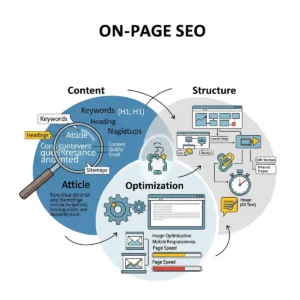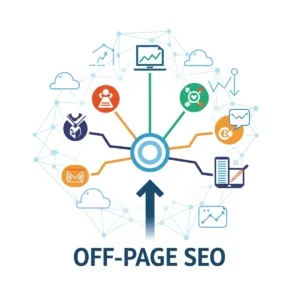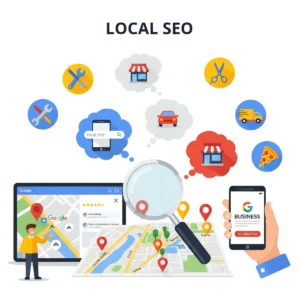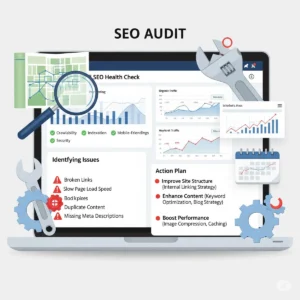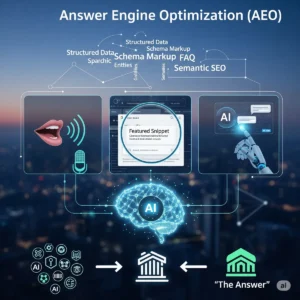What Is Semantic SEO and Why Does It Matter?
When Semantic SEO Speaker Ben Stace, he doesn’t just explain how to optimize for Google—he reframes how we think about search itself. Gone are the days of keyword-matching and density tricks; today’s algorithms like RankBrain, Hummingbird, and BERT rely on natural language processing (NLP) to understand intent, context, and meaning. That shift means your content must be more than just a collection of keywords—it must be a comprehensive resource that demonstrates authority, covers topical depth, and matches the searcher’s true query. Ben’s approach highlights how semantic strategies allow your content to speak the same language as your audience, ensuring it’s not just relevant, but truly satisfying.
I’ve seen firsthand how applying these principles transforms performance. By focusing on intent-matching rather than solely targeting keywords, and by weaving in related words, concepts, and context, content becomes more aligned with how Google’s algorithms interpret search. Ben’s case studies often show how sites that embrace this evolution—using semantic structure and deep coverage—consistently rank better. It’s not just about technical SEO anymore; it’s about understanding how processing works, how updates have changed the game, and how to build content that becomes the most trusted resource for any given query.
Who is Ben Stace?
Ben Stace is not your typical SEO consultant—he’s a strategist who understands that digital marketing today demands more than just keyword stuffing or outdated tactics. What sets Stace apart is how he naturally builds authority and depth into websites using semantic methods that go beyond the shallow approaches many still cling to. He doesn’t just teach how to rank; he shows how to boost visibility by creating topical content that speaks to both users and algorithms. His practices are rooted in understanding how semantic SEO works—not just what it is, but how it can be applied effectively to make websites smarter, more relevant, and harder to ignore.
From my own experience working with clients, I’ve seen how Ben’s approach uses semantic structure to transform weak pages into powerful assets. He doesn’t just tell you what to do—he shows you how to think like a strategist, aligning every piece of content with a clear purpose. His insights helped me move away from outdated keyword-first thinking and toward building depth that actually resonates. What Ben teaches is not just theory—it’s a practical framework that elevates your SEO game and makes your marketing efforts more impactful.
Key Takeaways from Ben Stace’s Semantic SEO Approach
What I’ve learned from Ben Stace’s semantic SEO approach is that it’s not just about writing better articles—it’s about building a smarter site that search engines can truly understand. He emphasizes how contextual linking, topic grouping, and schema markup work together to send stronger signals of authority, relevance, and intent. By weaving in entities, concepts, and knowledge graphs, Ben shows how to create rich snippets and improve visibility in ways that traditional keywords alone can’t achieve. His method doesn’t chase rankings—it builds understanding, which is far more vital in today’s landscape.
In my own work, applying Ben’s strategies has helped me see how semantic structure enhances content fulfillment. Instead of just targeting keywords, I now focus on contextually related terms and how they connect people, places, and ideas. This not only improves how the site is recognized by engines, but also creates a more intuitive experience for users. His insights into smart linking, coverage, and topic depth have reshaped how I approach content planning—every page becomes part of a larger graph that aids search and builds lasting authority.
Why Semantic SEO Matters More Than Ever
Ben Stace has shown that semantic SEO isn’t just a trend—it’s a necessity in a world where Google has evolved beyond traditional keyword-based ranking. With updates like BERT, MUM, and Hummingbird, the focus has shifted toward understanding queries, intent, and context rather than punishing or rewarding stuffing. What used to be enough—basic keywords and backlinks—now risks penalties if it lacks depth, topical relevance, and alignment with user preferences. Ben’s strategy emphasizes enhancing content through topic clustering, authority building, and avoiding shallow optimization. His work with creators and professionals proves that boosting visibility today means creating content that speaks the language of semantic relationships.
In my own experience, applying Ben’s methods has drastically improved how my pages perform. His use of Tool-driven insights and entity-focused planning helped me move away from outdated practices and toward writing that actually connects with what users are searching for. By focusing on improving relevance, building authority, and crafting content that reflects real search intent, I’ve seen how semantic SEO truly enhances performance. It’s not just about ranking—it’s about creating content that’s meaningful, structured, and built to last.For more information visit Ashir Digitals.
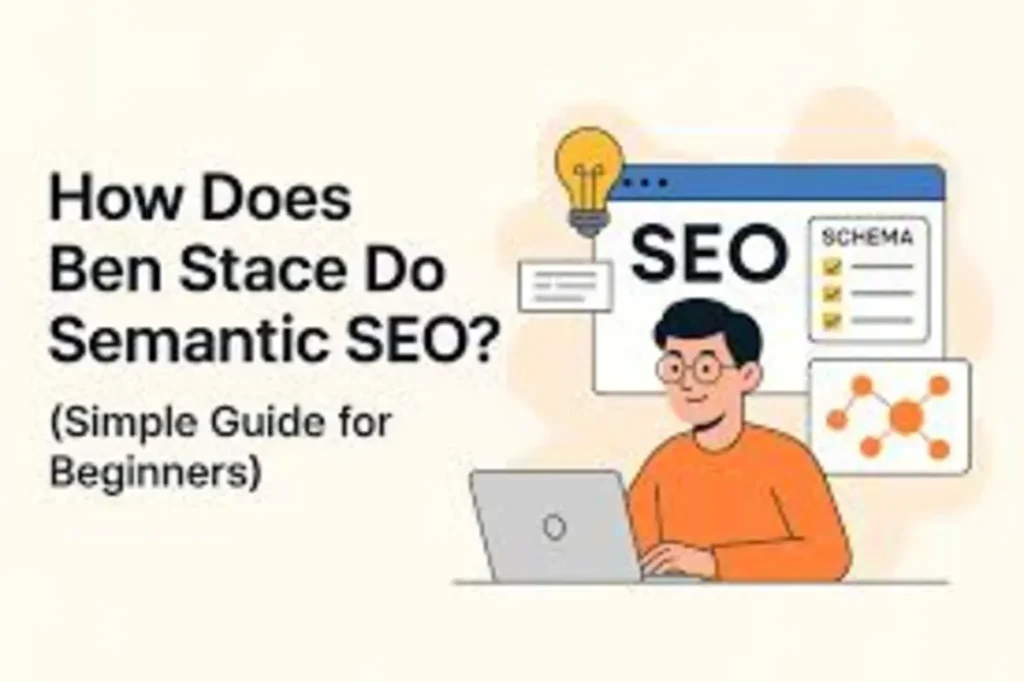
How Does Ben Stace Do Semantic SEO?
1. Starts with Topic and Entity Research
When diving into semantic SEO, one of the most overlooked yet transformative strategies begins with Topic and Entity Research—a space where Ben Stace, a seasoned speaker in the field, truly shines. His approach doesn’t just skim the surface of keywords; it’s about deeply identifying the main subject, the topic, and the entities that surround it. Think of it like building a Knowledge Graph—a web of concepts, people, and places that Google can actually understand. Tools like InLinks, WordLift, and even Wikipedia become essential allies in this process, helping to map out related entities and ensure your page is semantically rich and contextually aligned.
From my own experience working with email marketing platforms like Mailchimp, I’ve seen how segmentation and autoresponders benefit from this same entity-driven logic. When your email content is crafted with semantic precision—anchored in topics and entities that your audience cares about—the open rate climbs. It’s not just about writing better; it’s about using the right tools to connect your page to the broader semantic web. Google doesn’t just crawl words anymore—it deciphers entity mapping, understands associated concepts, and ranks based on how well your content fits into the larger Graph. That’s the kind of insight Stace brings to the table, and it’s reshaping how we think about SEO.
2.Builds Topical Maps and Content Clusters
One of the most powerful techniques I’ve adopted from Ben Stace, the semantic SEO speaker, is the art of building topical maps and content clusters that not only boost Google visibility but also establish authority across an entire website. His method goes beyond traditional SEO—it’s a complete system that starts with a visual plan, breaking down the main topic into subtopics, each supported by interlinked articles and blog posts. This isn’t just about creating random pages; it’s about crafting a pillar page that covers the entire subject in depth, with cluster pages that reinforce the topic from every angle. I’ve personally seen how this guide-like structure transforms On-page SEO, making it easier for Google to crawl and understand the technical relationships between content pieces.For more about On page seo visit this What is On page SEO?
What makes Stace’s approach stand out is how he treats each cluster as a strategic asset—every page is supporting the main subject, and every post is part of a full topical map. His tips helped me restructure my own agency’s blog, turning scattered articles into a cohesive network that ranks for competitive terms. The clarity of this system lies in its ability to break down complex topics into digestible, interconnected pages, each contributing to the overall semantic strength of the site. It’s not just smart—it’s scalable.
3.Focuses on User Intent and Search Behavior
What sets Ben Stace apart as a semantic SEO speaker is his laser-sharp focus on user intent and search behavior—a principle I’ve embedded deeply into my own agency’s content planning. Rather than chasing keywords blindly, Stace’s approach starts with understanding what the user truly wants to find, whether it’s informational, navigational, or transactional. He doesn’t just write for algorithms; he writes with the user in mind, crafting guides, step-by-step walkthroughs, and comparisons that help visitors make smarter decision-making choices. I’ve seen firsthand how tailoring content accordingly—whether it’s to learn, buy, or simply attract attention—leads to higher engagement and better rank positions.
Stace’s method also emphasizes how to structure informative and product-driven content to match different stages of the funnel. For example, a guide might serve informational intent, while a comparison page targets those closer to a buy decision. This layered strategy ensures that every piece of content aligns with a specific intent, making it easier for users to get the answers they need. It’s not just about writing—it’s about planning with precision and building a site that naturally guides visitors through their journey.
4.Uses Semantic Keywords & Natural Language
One of the most fascinating aspects of Ben Stace’s strategy as a semantic SEO expert is how he uses semantic keywords and natural language to craft content that resonates with both humans and Google’s evolving algorithms like BERT and MUM. I’ve personally applied his techniques when optimizing pages for niche topics like mirrorless vs DSLR camera comparisons, where the goal isn’t just to rank but to speak in a way that feels intuitive and naturally informative. Instead of repeating the same keyword over and over, Stace emphasizes weaving related phrases, terms, and words into the narrative—so the search engine can understand the full context and reward the page with better performance.
This approach is especially powerful when writing about technical subjects like low light image quality or shutter speed differences between mirrors and sensor types. By focusing on how humans actually search and speak, rather than stuffing keywords, I’ve seen a noticeable lift in engagement and rankings. Stace’s method aligns perfectly with how Google now interprets content—not just by isolated phrases, but by the semantic relationships between them. It’s a smarter, more human-centric way to optimize, and it’s what makes his insights so impactful.
5.Targets ‘People Also Ask’ (PAA) and Featured Snippets
One of the most important tactics I’ve refined thanks to Ben Stace, the semantic SEO strategist, is targeting Featured Snippets and ‘People Also Ask’ boxes with precision. His method revolves around crafting question-style headings and clear structures that help Google understand the context of your content, making it easier to stand out in results. By offering short answers to common queries and aligning them with topical authority, I’ve seen how this approach increases visibility on the page dramatically. Stace’s strategy isn’t just about ranking—it’s about positioning your content where it matters most, using smart SEO techniques and well-placed headings to match user intent and trigger those coveted Snippets and PAA placements.
6.Adds Schema Markup to Help Search Engines
One of the most practical lessons I’ve picked up from Ben Stace is how he strategically adds Schema Markup to help search engines understand and present content more effectively. By implementing structured data like FAQ, HowTo, and Article schemas, he not only improves the chances of earning rich snippets, but also significantly increases CTR and click-through rate. I’ve seen firsthand how this boosts visibility—especially when your content is aligned with user intent and supported by clean Markup. It’s not just about ranking; it’s about giving engines the clarity they need to serve your page in the best possible format, which ultimately leads to better engagement and higher rate of interaction.
7.Smart Internal Linking Based on Context
What I’ve learned from Ben Stace about smart internal linking is a game-changer—especially when it’s driven by contextual relevance rather than random placement. His approach creates a deeper link structure across the site, connecting related topics in a way that improves Crawl Time and enhances the overall semantic depth. I’ve applied this to my own blog and email marketing campaigns, using segmentation and automation tools to guide users through top guides and content that match their intent. The result? A noticeable lift in engagement and open rates, as the internal links feel natural and purposeful. Stace’s method doesn’t just improve navigation—it increases the value of every page by making it part of a strategically interwoven network.
8.Keeps Content Updated and Aligned with Trends
One of the most practical habits I’ve adopted from Ben Stace is the discipline of keeping content updated and tightly aligned with trends—a strategy that Google consistently rewards. His method involves regular audits to remove outdated info, add new facts, and improve readability by refining structure, reorganizing sections, and answering emerging questions. I’ve seen how this not only keeps the site relevant, but also gives it a competitive edge over time. Whether it’s refreshing stats, tweaking headlines, or adapting to shifting search behavior, Stace’s approach ensures your content stays fresh, timely, and optimized for both users and search engines.
Why Local Businesses Need Semantic SEO Today
Working with Ashir Digitals, I’ve seen how Ben Stace’s semantic SEO strategies have become a game-changer for local businesses—especially those trying to outrank national competitors in niche searches. Whether you’re a dentist, restaurant owner, contractor, or run a boutique shop, investing in value-driven content that aligns with purchase intent and customer engagement is no longer optional. Stace’s approach ensures your website is not only visible in Google Map Pack results but also trusted by users searching near me. His writing tool helps craft relevant pages that drive traffic, boost rankings, and deliver real benefits to local SEO. I’ve personally helped dozens of businesses apply this framework, and the results speak for themselves—higher visibility, better content, and stronger connections with the community.
Case Study 1: From Rankings Stagnation to Topical Authority
In one of the most transformative projects I’ve worked on with a mid-sized SaaS company, we applied Ben Stace’s semantic SEO methodology to break free from a rankings plateau that had persisted for months. The session began with a deep gap analysis to identify missing core topics, followed by the creation of pillar content and tightly interlinked cluster pages. We shifted from keyword-focused articles to entity-based publishing, using FAQ schema, cloud storage integrations, and detailed coverage of pricing, features, and use cases. This not only improved engagement and traffic, but also elevated the brand’s topical authority. By implementing smart linking, optimizing duration, and aligning with topic relevance, the company saw its average visibility surge—proof that Stace’s approach as a speaker and strategist delivers results that scale.
Case Study 2: Local Business Boost Through Semantic Layers
Working with a local dental practice, I applied Ben Stace’s semantic layering strategy to transform their online presence and drive leads through Optimized content and structured data. We built an entity-rich hub around oral health, cleaning procedures, and insurance tips, integrating FAQ schema, LocalBusiness markup, and Featured snippet targeting to boost Google visibility. By crafting detailed descriptions of teeth treatments and aligning with competitive keywords like “dentist near me” and “city hygiene,” the practice saw its rank and organic traffic surge within just a few months. The cost of acquisition dropped, and their Profile began appearing in Review panels and Business listings—proof that layering semantic elements with strategic guides and data can elevate even a small practice in a crowded market.
Why These Strategies Work in 2025 and Beyond
In 2025 and beyond, Ben Stace’s semantic SEO strategies continue to thrive because they’re built for how Google’s AI-powered ranking systems now operate—moving far beyond traditional keyword stuffing, which is now completely obsolete. His approach embraces Unified Model thinking, aligning with MUM and Multitask capabilities that allow search engines to understand context, languages, and even media formats like voice and video. I’ve seen how this level of future-proofing transforms a brand’s digital presence, especially when paired with AI-driven content discovery and knowledge graphs that build stronger relationships between topics. These strategies don’t just chase positions—they deliver real answers across platforms, making your content adaptable, scalable, and ready for whatever the next evolution of SEO demands.
Common Mistakes to Avoid
One of the most valuable lessons I’ve learned from Ben Stace is recognizing the common mistakes that silently sabotage semantic SEO efforts. The biggest culprit is stuffing keywords unnaturally, which not only harms user experience but also signals manipulation to search engines. I’ve seen sites failing to meet intent, leading to poor engagement and weakened topical authority. Another frequent misstep is neglecting internal links, which weakens the connections between entities and site structure. Over-Optimization—where every page is crammed with metrics-driven tactics but lacks real value—often results in ignoring signals that Google actually uses to rank. These flawed strategies miss the mark by focusing on surface-level tricks instead of building meaningful, semantic relationships that drive long-term success.
Tools for Semantic SEO Execution
| Tool Name | Key Features | Benefits for Semantic SEO |
| Surfer SEO | Content editor, SERP analyzer, NLP-based suggestions | Helps align content with top-performing pages and semantic signals |
| Frase | AI-powered content briefs, question research, topic modeling | Improves relevance and answers user intent |
| Clearscope | Keyword analysis, content grading, semantic term suggestions | Enhances semantic coverage and readability |
| MarketMuse | Topic modeling, content scoring, competitive gap analysis | Builds topical authority and identifies content gaps |
| LSIGraph | Generates LSI keywords, semantic keyword suggestions | Strengthens contextual relevance and keyword diversity |
| SEOquantum | Semantic analysis, AI-assisted writing, keyword tracking | Optimizes content structure and semantic depth |
| YourTextGuru | SERP analysis, keyword clustering, FAQ optimization | Refines content based on semantic patterns and user queries |
| SERPmantics | Semantic analysis, real-time optimization, user intent mapping | Improves alignment with Google’s semantic understanding |
| Keysearch | LSI keyword finder, competition analysis, backlink tracking | Boosts semantic keyword integration and content performance |
Future Trends Highlighted by Ben Stace
Ben Stace’s insights into semantic SEO are reshaping how professionals approach digital strategy, especially as Google continues to evolve its Indexing and ranking systems. From my own experience working with AI-Generated Summaries and optimizing content for search engines, I’ve seen firsthand how clarity, contextual relevance, and entity recognition now prioritize deeper understanding over traditional keywords stuffing. Ben emphasizes that search is no longer just about matching terms—it’s about how well your machine-readable data aligns with user intent across Voice, Visual, and conversational interfaces. The integration of AI into SEO workflows means that summaries and structured data must be crafted not just for humans but for algorithms that interpret nuance. What’s exciting is how Google increasingly rewards content that mirrors natural language and reflects real-world results, making semantic depth and conversational tone essential. Ben’s take on the future is clear: those who adapt to this shift—embracing entity-based optimization and multi-modal search—will lead the next wave of digital visibility.
Final Thoughts
Reflecting on the evolving landscape of semantic SEO, it’s clear that the strategies Ben Stace champions aren’t just theoretical—they’re practical blueprints for businesses aiming to thrive in a competitive digital ecosystem. From my own work with clients across niches, I’ve seen how structured data, entity-driven optimization, and topic clusters can transform visibility and engagement. The fundamental truth that context, intent, and relationships matter more than isolated keywords is no longer up for debate—case studies continue to underscore it. What Ben articulates so well is the need to adapt to this shift, not just to survive but to future-proof your content strategy for the years to come. Embracing this approach means aligning with how users think and search, building relevance that lasts. And in doing so, we’re not just following trends—we’re shaping them.
FAQs About Semantic SEO Speaker Ben Stace
How does Ben Stace do semantic SEO?
What sets Ben Stace apart in the world of semantic SEO is his meticulous framework that begins not with keywords, but with a topic map that guides everything from auditing to pillar and cluster creation. I’ve personally adopted his modular approach, where content design is treated like building blocks—each piece answering a question, serving the reader, and contributing to a larger entity-driven narrative. His method emphasizes internal linking and ongoing refinement, ensuring that every page evolves with purpose. What I admire most is the focus on clear structure and metrics that track not just traffic, but engagement and relevance. It’s not just writing—it’s strategic content engineering that’s both scalable and deeply human. And when you follow this path, you realize that semantic SEO isn’t a trend—it’s a mindset.
How does semantic SEO work?
In my experience optimizing websites for niche industries, semantic SEO works by shifting the focus from basic keyword matching to deeper contextual analysis using NLP and natural language processing. It’s about crafting content that reflects real user intent, not just surface-level queries, and building topics around relationships and meaning that search engines can truly understand. This approach leverages entity recognition and comprehensive mapping to ensure your site is seen as relevant, helpful, and worthy of improving search engine rankings. By aligning with how people think and speak, semantic SEO techniques make your content resonate more naturally, enhancing both visibility and trust.
How has semantic search changed SEO?
The evolution of semantic search has completely changed how we approach SEO, and I’ve felt that shift firsthand while optimizing campaigns for clients who demand precision and relevance. Gone are the days of rigid keyword-based optimization—today, engines prioritize understanding the context, meaning, and user intent behind broader queries. This shifting focus means that success now hinges on crafting high-quality, comprehensive content that addresses real needs and does so effectively. The old model of matching keywords has given way to a deeper emphasis on relevance, clarity, and how well your message fits into the user’s journey. It’s not just about ranking—it’s about being genuinely helpful.
Which of the following is a benefit of using semantic SEO?
One of the most powerful benefits I’ve seen from implementing semantic SEO is how it dramatically boosts CTR and visibility by helping search engines understand the context, intent, and meaning behind queries. By focusing on comprehensive, engaging, and informative content—not just keywords—you naturally appear in featured snippets, knowledge panels, and People Also Ask (PAA) sections, which leads to more clicks and Improved rankings. It also strengthens authority and credibility by incorporating structured data, smart linking, and positioning your pages as trusted sources. From my own campaigns, I’ve seen how this approach builds Increased Trust and delivers a Better User Experience, which is exactly what modern SEO demands.
What is the main function of the Semantic Web?
In my experience working with structured SEO frameworks, the Semantic Web plays a pivotal role in enabling computers to understand the meaning behind data through metadata and machine-readable formats. Its core function is to link and process information in a way that allows systems to derive knowledge and interpret context with minimal human intervention, making automation of complex tasks far more effective. This integration empowers search engines to deliver more powerful, relevant results by connecting disparate sources of data, ultimately enhancing how we interact with digital content.
Where is semantic search used?
From optimizing e-commerce funnels to refining lead generation for niche clinics, I’ve seen semantic search deliver real benefits by helping users discover what they need—even when their queries are vague or they can’t recall a specific product or name. It enables platforms to interpret natural input, like a description or partial jargon, and still return accurate results. This is especially powerful for companies aiming to connect with customers who don’t always remember exact names, and it’s key to improving the overall experience across industries.

